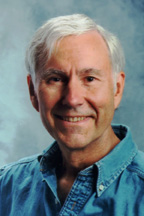Never Be Sick AgainPowerful Patient, 2008 Week 33Joyce Graff, host, on webtalkradio.net Beginning August 11, 2008
Raymond Francis was on the brink of death when he decided to take charge of his own health and apply his knowledge of biochemistry to researching a solution to his grave illness. He shares his new theory: “There is only one disease, and you can cure it.”
About Our Guest
Raymond Francis, M.Sc., trained as a chemist at M.I.T., was in acute liver failure and on the brink of death when he decided to take charge of his own health. His doctors had failed him, and in fact had made him significantly worse. As a biochemist, he was familiar with how the body works, and how to look for answers. He quit his job, set his mind to researching the problem, and in two years he was back to health.
He shares his model of health in a book, Never Be Sick Again, and on his website, http://www.beyondhealth.com. “Conventional medicine does an excellent job of describing diseases and suppressing symptoms, but very rarely are diseases cured. The Beyond Health Model identifies and addresses the root causes of disease. When you focus on addressing the causes, problems can be solved.”
His concept is simple: there is only one disease and only two causes of disease.
You can order a copy of his book from Amazon.com or other bookstores, or if you call Beyond Health 800-250-3063 and tell them you heard about it on the Powerful Patient, they will give you a year’s free subscription to his newsletter.
Healing Yourself
Raymond was in a very precarious health condition before he began this research. His allergist had administered an intradermal allergy test which provoked a very serious reaction. As a result, he developed three autoimmune diseases – Hashimoto’s thyroiditis, Sjogren’s syndrome, Lupus, Chronic Fatigue Syndrome, and chemical hypersensitivity syndrome. Subsequently he visited 36 medical doctors, who described his condition with a variety of medical names, but offered no solutions. A few suggested that he was a hypochondriac. “At the time, I thought all of my doctors were baffled because my case was so complex. In the end, however, the answers proved to be simple. The answers had been there all along. One just needed to know where to look.”
One of the physicians he saw prescribed an antiparasitic drug, metronidazole, which turned out to be hepatoxic (poisonous to the liver). He suffered a severe reaction to the drug. “In my weakened and chemically sensitive condition I should never have been given this drug, as I would later learn from the medical literature. Perhaps I should have known better, given my prior experiences with medical doctors, but trusting the doctor and knowing of no other options, I took the drug. Metronidazole is known to be stressful to the liver, and my liver was already under a lot of stress. I could not handle the additional toxic load. My liver failed, and I was at death’s door.”
Two years later, after a great deal of work and research, Raymond had healed himself and had begun to formulate the simple theory of disease he presents in his book. His theory is that there is only one disease: malfunctioning cells. There are only two causes of disease: deficiency and toxicity (the cells are lacking some important nutrient, or they are being bombarded with some toxin). And that there are six “pathways” along which we may become more sick or more healthy, depending on the choices we make:
Health, he says, is not an end point but a continuum. With each choice we make we move along that continuum toward health, or away from health.
Even those with genetic risk factors can gain control over their health. “Many people assume that “bad genes” or a family history of disease predestines them to be sick. In truth, while genetic predispositions do put a person at risk for disease, what a person chooses to do to protect the health of their cells and genes plays a more important role in whether or not disease develops. Choices, rather than genetic inheritance, are the key. We must focus on how we play the game, not the cards we were dealt; what we eat, what we do and what we are exposed to determines how healthy we will be.” [Never Be Sick Again, pages 81-82]
The four primary things to avoid: sugar, white flour, processed oils, milk products
Reducing your exposure to toxins
While you cannot control all the toxins in your environment, you can manage those under your control. According to Raymond, 80% of the toxins in your environment are in fact under your personal control. Read labels, and look for non-toxic alternative brands:
About mercury fillings in teeth
If you have silver-colored fillings in your teeth, you have mercury in your teeth. Some people are more sensitive to this than others.
A number of countries, including Sweden, Denmark, Finland, Austria, and Germany, have banned the use of mercury amalgam in filling teeth. There are now plastic composites that are safe and just as durable as amalgam. There are bills before the U.S. Congress requesting the banning of mercury-containing amalgam, but these have not yet passed. The American Dental Association continues to insist that amalgam is safe. However, a number of people have been recognized as having symptoms caused by mercury and other heavy metals leeching from their fillings into their bodies. Symptoms may mimic lupus or other autoimmune diseases, and Multiple Sclerosis. You can find out if this is an issue for you by having a heavy metal screening test.
Some interesting articles on this subject:
http://www.cbsnews.com/stories/2005/08/12/health/webmd/main774242.shtml
Please note that pregnant women should NOT have mercury fillings polished or removed during pregnancy because of the danger of exposing the fetus to mercury, which can impact brain development. Wait until after delivery for these procedures.
|
